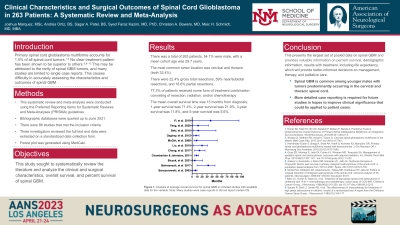Clinical Characteristics and Surgical Outcomes of Spinal Cord Glioblastoma in 182 Patients: A Systematic Review and Meta-Analysis
Clinical Characteristics and Surgical Outcomes of Spinal Cord Glioblastoma in 182 Patients: A Systematic Review and Meta-analysis
Friday, April 21, 2023

.jpg)
Joshua Marquez, MSc (he/him/his)
Medical Student
University of New Mexico School of Medicine
ePoster Presenter(s)
Introduction: Primary spinal glioblastoma multiforme (GBM) is an aggressive tumor that makes up 1-5% of all GBM tumors and 1.5% of all spinal cord tumors. The purpose of this systematic review and meta-analysis was to analyze the data on the clinical features, surgical treatment, and overall survival of patients diagnosed with spinal GBM.
Methods: This systematic review and meta-analysis was conducted using the PRISMA guidelines. A search of bibliographic databases up to June 2021 was performed, which consisted of case reports, case series, and retrospective single-center studies. There were 42 studies included in our final qualitative systematic review and quantitative meta-analysis.
Results: There were 182 patients from the 42 studies. There was a male predominance of 53.4% and a mean cohort age of 30.2 years. The most common presenting symptoms included back pain, sensory deficits, motor deficits, and urinary dysfunction, all correlating with neuroanatomical effects of tumor location. The most common tumor location was cervical (32.4%), followed by thoracic (31.2%), cervicothoracic & thoracolumbar (both 13.3%), and lumbar spine (6.4%). There were 132 tumor resections, with 28 (21.2%) gross total resections (GTR), 84 (63.6%) subtotal resections (STR), and 20 (15.2%) partial resections (PR). Recurrence occurred in 48.4% of patients, 72.4% received radiation therapy, and 57.8% received chemotherapy. The mean overall survival time was 15.6 months from diagnosis; 1-year survival was 64.6%, 2-year survival was 20.1%, 3-year survival was 11.1%, and 5-year survival was 5.6%.
Conclusion : This novel systematic review and meta-analysis presents the initial pooled quantitative data on spinal GBM. The baseline study helps provide demographic information, results with treatment, including life expectancy, and will provide better-informed decisions on management, therapy, and palliative care for spinal GBM patients.
Methods: This systematic review and meta-analysis was conducted using the PRISMA guidelines. A search of bibliographic databases up to June 2021 was performed, which consisted of case reports, case series, and retrospective single-center studies. There were 42 studies included in our final qualitative systematic review and quantitative meta-analysis.
Results: There were 182 patients from the 42 studies. There was a male predominance of 53.4% and a mean cohort age of 30.2 years. The most common presenting symptoms included back pain, sensory deficits, motor deficits, and urinary dysfunction, all correlating with neuroanatomical effects of tumor location. The most common tumor location was cervical (32.4%), followed by thoracic (31.2%), cervicothoracic & thoracolumbar (both 13.3%), and lumbar spine (6.4%). There were 132 tumor resections, with 28 (21.2%) gross total resections (GTR), 84 (63.6%) subtotal resections (STR), and 20 (15.2%) partial resections (PR). Recurrence occurred in 48.4% of patients, 72.4% received radiation therapy, and 57.8% received chemotherapy. The mean overall survival time was 15.6 months from diagnosis; 1-year survival was 64.6%, 2-year survival was 20.1%, 3-year survival was 11.1%, and 5-year survival was 5.6%.
Conclusion : This novel systematic review and meta-analysis presents the initial pooled quantitative data on spinal GBM. The baseline study helps provide demographic information, results with treatment, including life expectancy, and will provide better-informed decisions on management, therapy, and palliative care for spinal GBM patients.
